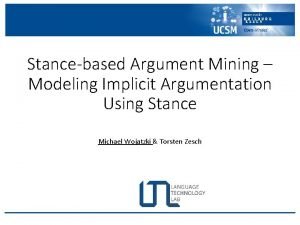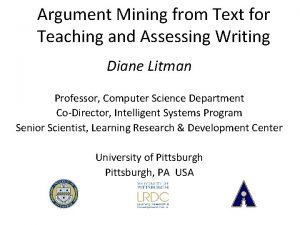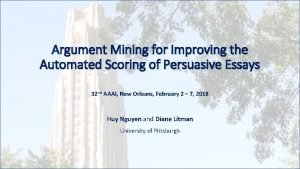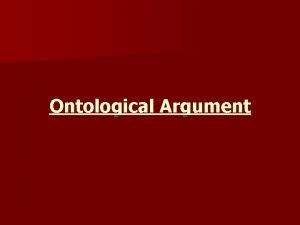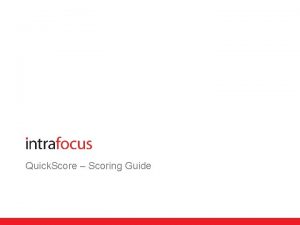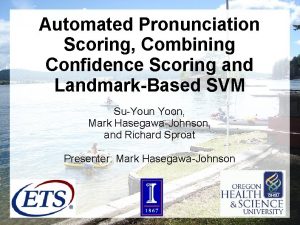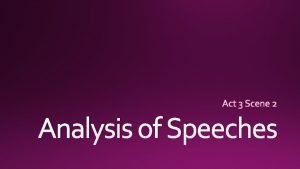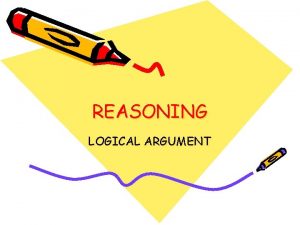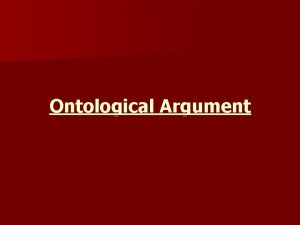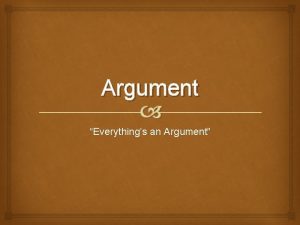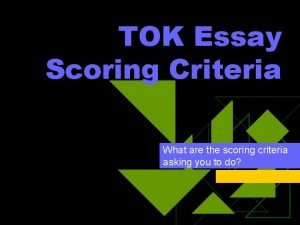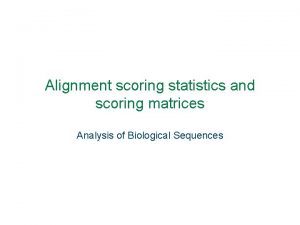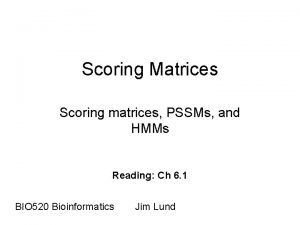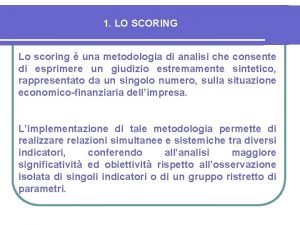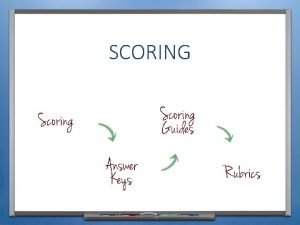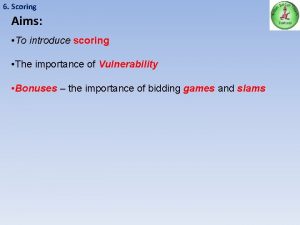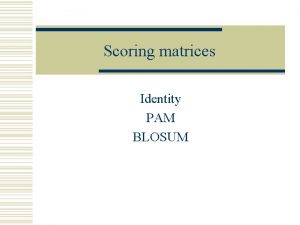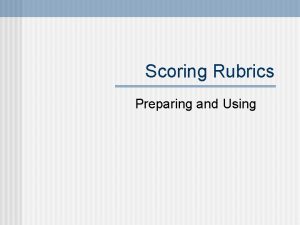Argument Mining for Improving the Automated Scoring of




![What is argument mining? • “[…] the automatic discovery of an argumentative text portion, What is argument mining? • “[…] the automatic discovery of an argumentative text portion,](https://slidetodoc.com/presentation_image_h/b868fbbbcc25884dbd1fd4236f0f4794/image-5.jpg)

![Argument mining pipeline [Nguyen & Litman, 2014, 2015, 2016, 2018] • Trained/tested using an Argument mining pipeline [Nguyen & Litman, 2014, 2015, 2016, 2018] • Trained/tested using an](https://slidetodoc.com/presentation_image_h/b868fbbbcc25884dbd1fd4236f0f4794/image-7.jpg)











![Argument mining tasks [Persing & Ng, 2016] [Stab & Gurevych, 2016] [Nguyen & Litman, Argument mining tasks [Persing & Ng, 2016] [Stab & Gurevych, 2016] [Nguyen & Litman,](https://slidetodoc.com/presentation_image_h/b868fbbbcc25884dbd1fd4236f0f4794/image-19.jpg)



- Slides: 22

Argument Mining for Improving the Automated Scoring of Persuasive Essays 32 nd AAAI, New Orleans, February 2 – 7, 2018 Huy Nguyen and Diane Litman University of Pittsburgh

Introduction 2

Emerging needs in education • Argumentation and argumentative writing receive increasing attention • Key focuses of Common Core Standard • Standardized tests, academic content courses [Persing & Ng, 2013] [Rahimi & Litman, 2014] • Emerging attention to evaluating argument aspects of essays • Thesis clarity, evidence use, critical question, argument strength [Song et al. , 2014] [Persing & Ng, 2015] • Existing automated scoring systems have not considered argumentation aspect • A demand for “argumentation-aware” automated writing evaluation systems [Beigman Klebanov et al. , 2016] 3

Persuasive essay writing rubrics • TOEFL i. BT Independent Writing • “… is well organized and well developed, using clearly appropriate explanations, exemplifications and/or details” • Kaggle ASAP: automated student assessment prize • “Has fully elaborated reasons with specific details…” • … Our study: Argument Mining (AM) for new capabilities that improve Automated Essay Scoring (AES) 4
![What is argument mining the automatic discovery of an argumentative text portion What is argument mining? • “[…] the automatic discovery of an argumentative text portion,](https://slidetodoc.com/presentation_image_h/b868fbbbcc25884dbd1fd4236f0f4794/image-5.jpg)
What is argument mining? • “[…] the automatic discovery of an argumentative text portion, and the [Peldszus & Stede, 2013] identification of the relevant components of the argument presented there. ” • Argument component: argumentative discourse unit (ADU) • E. g. , text segment, sentence, clause • Argument mining (AM) pipeline with three steps: • Separates argumentative from non-argumentative text units • Labels argument components with their argumentative roles, e. g. , premise, claim • Recognizes if two argument components are argumentatively related (e. g. , support) or not 5

Argument Mining for Automated Essay Scoring 6
![Argument mining pipeline Nguyen Litman 2014 2015 2016 2018 Trainedtested using an Argument mining pipeline [Nguyen & Litman, 2014, 2015, 2016, 2018] • Trained/tested using an](https://slidetodoc.com/presentation_image_h/b868fbbbcc25884dbd1fd4236f0f4794/image-7.jpg)
Argument mining pipeline [Nguyen & Litman, 2014, 2015, 2016, 2018] • Trained/tested using an AM corpus of 402 essays Argument Component Identification Argumentative vs. Not AM challenges [Stab & Gurevych, 2016] Argumentative Relation Classification as Support or Not ACCClassification Argument Component Limited training data. Claim or Premise as Major Claim, • • End-to-end performance Premise 1: city life has its own advantages ACI atmosphere, friendliness of Premise 2: peaceful • Essay quality disparity training vs. test data “In conclusion, I would concede that city life has its own advantages. Nonetheless, peaceful atmosphere, friendliness of people, and green landscape strongly convince me that a small town is the best place for me to live in. I love the life in my town. ” people, and green landscape strongly ARCconvince me Claim: a small town is the best place for me to live in Premise 1 Attack Claim t por Sup Premise 2 Attack (Premise 1, Claim) Support (Premise 2, Claim) • End-to-end performance (suffered from error propagation) • Argument component identification • Argument component classification • Support relation identification F 1 = 0. 87 F 1 = 0. 42 (0. 82 with true-label inputs) F 1 = 0. 38 (0. 73 with true-label inputs) 7

End-to-end argumentation feature extraction Student writings Argumentation features ACC AES ACI ARC Other AES features 8

Contribution of our study • 7 key attributes to evaluate argument mining for AES Holistic score Advanced baseline End-toend AM Relation features Feature ablation Multiple dataset Crossprompt Persing & Ng 2015 Wachsmuth et al. 2016 Ghosh et al. 2016 Klebanov et al. 2016 Our study 9

AES Data and Prediction Features 10

AES data sets • Kaggle’s ASAP* • Essays by students in Grades 7 to 10 • 2 sets of persuasive essays: [Blanchard et al. , 2013] • TOEFL 11 • Essays by non-native test takers • 8 prompts, 8000+ opinionated essays • Prompt 1: computer usage • Categorical scores üin. No common essays with AM data • Prompt 2: censorship library ü No AM annotation available • Data statistic Prompt 1 Prompt 2 Training Test #essays 1783 1800 #essays 6074 2023 Word-count/essay 350 Low score 655 222 Score range 2 – 12 1– 6 Medium score 3318 1101 Score median 8 3 High score 2101 700 * Automated Student Assessment Prize https: //www. kaggle. com/c/asap-aes/data 11

Base AES models • EASE* system, ranked 3 rd in ASAP • Length features • word, character counts, average word length, number of questions… • Prompt features • Number of essay words found in prompt, words that have synonyms in prompt… • Bo. W features • Refined unigram, bigrams • POS features • Our implementation for TOEFL 11 data • Length • Character, word, sentence count • Average word and sentence lengths • Content • Spelling errors, stop-words, prompt words • Punctuation counts, e. g. , commas, question marks • SAT word count • POS sequences found in English literature * https: //github. com/edx/ease 12

Argumentation Feature sets Argument Component Features (AC) 1, 2 Argumentation Feature Sets • 33 features in 5 categories • • from prior studies * proposed in this study 3, 4 5 6 7 Number and fraction of argument components over total number of sentences in essay Number and fraction of argumentative sentences Total number of words in argument components Number of paragraphs containing argument components Whether the essay has paragraph without any argument component Argument component identification Argument Component Label Features (CL) 8 9, 10 11, 12 13 Number of Major Claims Number and fraction of Claims over total number of sentences Number and fraction of Premises Average number of Premises per Claim Argument Flow Features (AF) 14 15 16 17 – 24 Number of paragraphs that contain Major Claims and Claims Number of paragraphs that contain Major Claims and Premises Number of paragraphs that contain Claims and Premises Frequency of 8 typed bigrams of argument components Argument component classification Argumentative Relation Features (RL) [Persing & Ng, 2015] [Wachsmuth et al. , 2016] [Ghosh et al. , 2016] [Beigman Klebanov et al. , 2016] 25 26 27 28 Number of supported Claims Number of dangling Claims Number of supporting Premises Number of paragraphs that have support relations Argumentation Structure Typology Features (TS) 29 30 31 32 33 Number of Chain-structures Number of Tree-structures with height = 1 Number of paragraphs that contain Chain-structures Number of paragraphs that contain Tree-structures Support relation identification 13

Experiment Results 14

10 -fold cross validation performance • Taghipour and Ng (2016) achieved the state-of-the-art with ASAP data (averaged over 8 prompts) • We experiment with 2 prompts of persuasive essays • Argumentation features help improve Limited amount of AES research on TOEFL 11 base data competitive AES models ASAP p. 1 ASAP p. 2 TOEFL 11 (Taghipour and Ng, 2016) 0. 821 0. 688 - Baseline 0. 831 0. 680 0. 599 ARG 0. 790 † 0. 620 † 0. 494 † ALL (Baseline + ARG) 0. 830 0. 689 * 0. 611 * Symbols * and † indicate significantly higher and lower than baseline values (p < 0. 05). Best values are in boldface. 15

Cross-prompt validation performance • ASAP data • Dong and Zhang (2016) obtained the best over -all cross-prompt (averaged over 8 prompts) • We use prompt 1 as training and prompt 2 as test data • TOEFL 11 • 8 -fold cross prompt • Argumentation features help improve crossprompt performance ASAP TOEFL 11 (Dong and Zhang 2016) 0. 569 - Baseline 0. 585 0. 591 ARG 0. 567 0. 492 † ALL (Baseline + ARG) 0. 622 0. 600 * Symbols * and † indicate significantly higher and lower than baseline values (p < 0. 05). Best values are in boldface. 16

Summary • This study brings up a strong support of application of AM in AES • • End-to-end AM for improving holistic score prediction The largest argumentation feature set Competitive base AES models In- and cross-prompt evaluations • Automated writing assessment and auto-feedback • Automated assessment of argumentative writing in peer-review/tutoring systems • Feedback on argumentation structure, argument quality 17

Thank you! AM AES 18
![Argument mining tasks Persing Ng 2016 Stab Gurevych 2016 Nguyen Litman Argument mining tasks [Persing & Ng, 2016] [Stab & Gurevych, 2016] [Nguyen & Litman,](https://slidetodoc.com/presentation_image_h/b868fbbbcc25884dbd1fd4236f0f4794/image-19.jpg)
Argument mining tasks [Persing & Ng, 2016] [Stab & Gurevych, 2016] [Nguyen & Litman, 2018] • Argument component identification • Separates argumentative from non-argumentative text units • Argument component classification • Labels argument components with their argumentative roles, e. g. , premise, claim • Argumentative relation classification • Recognizes if two argument components are argumentatively related (e. g. , support) or not Claim (1) (1)[Taking care of thousands of citizens who suffer from disease or illiteracy is more urgent and pragmatic than building theaters or (2)As sports stadiums]. Claim. (2)a. As matter a matter of fact, [an uneducated person may barely mayappreciate barely appreciate musicals], musicals] whereas [a , physical whereasdamaged [a physical Premise damaged person, resulting person, from resulting the lack fromofthe medical lack oftreatment, medical treatment, may no (3)Therefore, . [providing (3)Therefore, may longer noparticipate longer participate in any sports in anygames]. sports games] Premise [providing education and medical and care medical is more care essential is moreand essential prioritized and to prioritized the government]. to the government]Claim. Premise(2. 1) supports Claim(1) Premise(2. 2) supports Claim(1) Claim(3) supports Claim(1) Claim (3) Premise (2. 1) Premise (2. 2) 19

Argument mining pipeline • Trained/tested using a persuasive essay corpus of 402 essays [Stab & Gurevych, 2016] • End-to-end performance (suffered from error propagation) • Argument component identification • Argument component classification • Support relation identification F 1 = 0. 86 F 1 = 0. 42 F 1 = 0. 38 Argument Component Identification Argumentative vs. Not [Nguyen & Litman, 2014, 2015, 2016, 2018] Argumentative Relation Classification as Support or Not ACCClassification Argument Component as Major Claim, Claim or Premise “In conclusion, I would concede that city life has its own advantages. Nonetheless, peaceful atmosphere, friendliness of people, and green landscape strongly convince me that a small town is the best place for me to live in. I love the life in my town. ” Premise 1: city life has its own advantages ACI atmosphere, friendliness of Premise 2: peaceful people, and green landscape strongly ARCconvince me Claim: a small town is the best place for me to live in F-1 score: 0. 87 F-1 score: 0. 82 Premise 1 Attack Claim t por Sup Premise 2 Attack (Premise 1, Claim) Support (Premise 2, Claim) F-1 score: 0. 73 20

Feature ablation ASAP p. 1 ASAP p. 2 TOEFL 11 ASAP TOEFL 11 (Taghipour and Ng, 2016) 0. 821 0. 688 - (Dong and Zhang 2016) 0. 569 - Baseline 0. 831 0. 680 0. 599 Baseline 0. 585 0. 591 ARG 0. 790 † 0. 620 † 0. 494 † ARG 0. 567 0. 492 † ALL (Baseline + ARG) 0. 830 0. 689 * 0. 611 * ALL (Baseline + ARG) 0. 622 0. 600 * ALL – AC 0. 830 0. 676 0. 610 * ALL – AC 0. 610 0. 600 * ALL – CL 0. 832 0. 689 * 0. 608 * ALL – CL 0. 596 0. 600 * ALL – AF 0. 830 0. 688 * 0. 604 ALL – AF 0. 611 0. 601 * ALL – CL 0. 831 0. 687 0. 606 * ALL – RL 0. 626 0. 595 * ALL – TS 0. 831 0. 688 0. 611 * ALL – TS 0. 622 0. 601 * 21

22
 Teckenspråk minoritetsspråk argument
Teckenspråk minoritetsspråk argument Score a script
Score a script Difference between strip mining and open pit mining
Difference between strip mining and open pit mining Web text mining
Web text mining Strip mining vs open pit mining
Strip mining vs open pit mining Multimedia data mining
Multimedia data mining Strip mining before and after
Strip mining before and after Eck
Eck Argument mining
Argument mining Argument mining
Argument mining Argument mining
Argument mining Ontological argument
Ontological argument Stig kerman
Stig kerman Tack för att ni lyssnade
Tack för att ni lyssnade Varför kallas perioden 1918-1939 för mellankrigstiden?
Varför kallas perioden 1918-1939 för mellankrigstiden? Tobinskatten för och nackdelar
Tobinskatten för och nackdelar Hur ser ett referat ut
Hur ser ett referat ut Atmosfr
Atmosfr Byggprocessen steg för steg
Byggprocessen steg för steg Var finns arvsanlagen
Var finns arvsanlagen Urban torhamn
Urban torhamn Rbk mätning
Rbk mätning Påbyggnader för flakfordon
Påbyggnader för flakfordon








